John Wayne on the Backlot
twentieth century Fox

Marion Morrison apprenticed on the Fox lot it still was the “William Fox West Coast Studio”, then situated at 1401 N. Western Avenue. It took John Wayne 30 years to return to the Fox lot. It had become Twentieth Century Fox in a merger with 20th Century Pictures in 1935. The corporation was selling off large junks of its lot when he shot the western town scenes of The Comancheros on the often-used 1936 Tombstone Street. It was razed to the ground even as Wayne was filming.
monogram pictures
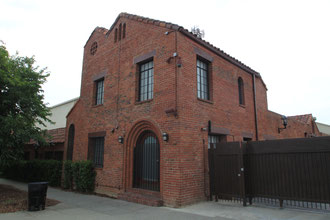
In 1933, John Wayne went with Trem Carr’s Monogram Pictures, then headquartered at 6048 Sunset Boulevard, to make a series of cheapie westerns under the „Lone Star” brand. The brick stone buildings can still be seen on Hoover Street. Sometimes...

...they would just go outside on the street corner and start shooting a scene, as this still from The Hurricane Express proves. In 2011, Scientology bought the old lot where John Wayne used to film his early serials.
columbia pictures

Movie mogul Harry Cohn funded Columbia Pictures Studios in 1918, in the Poverty Row area of Hollywood, bounded by Sunset Boulevard on the North, Gower on the West, and Beachwood Drive on the East. He put young John Wayne under contract in his early days. This photograph shows the Gower Gulch entrance, where the Cohn's studios used to be.

When you trod around the former location of the Columbia Pictures Studios at Gower, look up the Beachwood Street. That’s where the Columbia gate was, and that’s where the gateman refused John Wayne admittance – on Harry Cohn’s orders, after he dropped his young contract player, John Wayne.
Republic Pictures
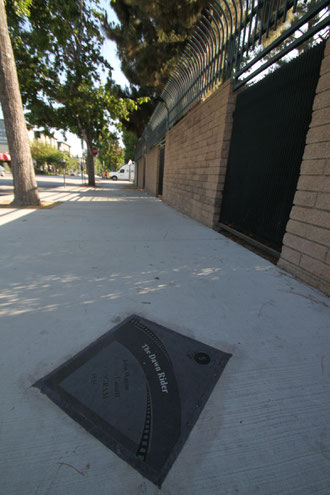
In the fall of 1935, former tobacco executive Herbert J. Yates absorbed Wayne’s employers Mascot and Monogram as well as other production entities and formed Republic Pictures. This new studio complex was on Ventura and Radford in the San Fernando Valley would become John Wayne’s studio home for the next eighteen years, the longest he was ever associated with one studio. By the end of the decade, the “biggest of the little studios” was out of the moviemaking business. In May 1962, the CBS Television Network took over the lot. CBS Studio Center at 4024 Radford Ave still uses the grounds primarily for television. Several memorial markers in the ground outside their walls remind visitors of its former glory. A parking lot is now where the old western street was where John Wayne rode in these early sagebrush dramas.

John Wayne returned to his old stoming grounds at Republic in 1970, when Herbert Yates was long gone. The interior shots for Rio Lobo took twenty-two days to shoot on Soundstage 18. Wayne's final visit to the former Republic facilities came in 1974, when he made an appearance on CBS television, in the episode „Maude Meets the Duke“ of the sitcom All in the Family.
Warner brothers

After John Wayne had escaped the Mascot serials, the door opened to Warner Brothers, on what has become Warner Boulevard in North Hollywood. The struggling actor had managed to get a six-picture deal for a series of quickie westerns. What is now Forest Lawn Cemetery on Forest Lawn Drive was once the „Providencia Ranch“, where several outdoor movies, as well as John Wayne’s early Warner westerns, were filmed. After being absent from the studio for eighteen years, John Wayne returned as the country’s number one box office attraction to the Warner Burbank Studios. His first, Operation Pacific (seen here with Ward Bond), is a perfect example of a studio-bound film. Even though the story is set in Honolulu, not a foot of film was shot there, apart from some stock footage and establishing shots.

John Wayne worked on the Warner stages time and again. Rio Bravo cut back and forth between the streets of Old Tucson and the interiors on Stage 4 (now Stages 5 and 10). Stage 1 saw the fight to the death between John Wayne and Bruce Dern – the haunting night scene from The Cowboys.

As a director, John Wayne used the Warner backlot for The Green Berets. He dressed the „French Street“ (the Paris scenes of the Casablanca flashback were set there) as well as the „New Orleans Street“ as his "Saigon" streets. Some of the Vietnam jungle scenes were shot on the backlot as well, in Warner’s jungle section, like the poignant scene of Peterson's death, pictured here.
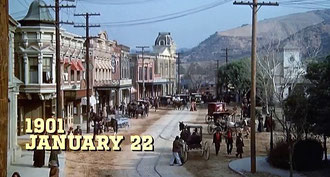
John Wayne was back in the Warner Burbank studios for his final movie, The Shootist. Most of the „Carson City“ set was built on „Midwest Street“ (Warners had rented it out to Paramount). The interior of Lauren Bacall’s boarding house was created on Soundstage 14, as well as the interior of Doc Hostettler’s (James Stewart) residence. Up till 1970, the Ponderosa Ranch had taken up the space of this 21,280-square-foot stage.

The Metropolitan Saloon, the set for John Wayne’s last showdown, was built on Stage 25 at a cost of $150,000. As a director and producer, John Wayne used that same stage for some interior shots of his war movie The Green Berets. Stage 25 was deemed „The Big Bang Theory Stage“ in 2019.
"Fat" jones stables
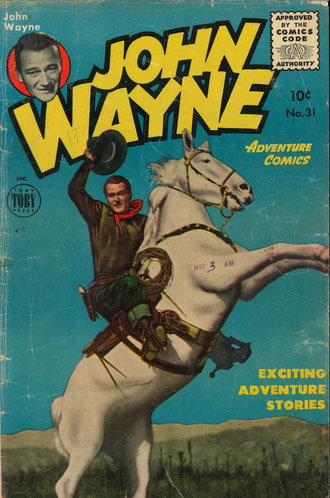
In 1933, “Fat” Jones moved his horse rental business in Placerity Canyon to North Hollywood where he became indispensable for western moviemakers. Most of the horses John Wayne used in the early westerns were rented from „picture barns“. “Fat” Jones Stables at 11340 Sherman Way in North Hollywood was probably the best known of the movie horse suppliers. In his Warner westerns from 1932-33, John Wayne was teamed with a white stud called "Duke".
metro-goldwyn-mayer

John Wayne worked for MGM first as an extra in silent movies, then as a full-fledged star. MGM was the most prodigious of the dream factories, founded in 1924 when Metro, Goldwyn and Louis B. Mayer Pictures merged in Culver City. The historical marker for the Ince/Triangle Studios that formed the original lot is located at 10202 W. Washington Blvd, on the landmark MGM colonnade, pictured here at night.

The lion in the logo had just been introduced when John Wayne was working at MGM for the first time, in the summer of 1926, as a costumed extra, wearing a kilt, in Annie Laurie. When he walked through the MGM colonnade at 10202 W. Washington Blvd again, it was wartime, in 1942, and Wayne was an A-lister, starring in the Joan Crawford war melodrama Reunion in France.

This historical marker is found at the site where the first motion picture studio in Culver City was built, later to become Metro-Goldwyn-Mayer. John Wayne worked here first as an extra in silent pictures. He walked trhough the landmark MGM colonnade at at 10202 W. Washington Blvd years later, to star in big MGM moneymakers.

The original entrance to the studio of Metro-Goldwyn-Mayer, where John Wayne worked on classics like They Were Expandable, as it is today: it's still the entrance to a studio lot - now Sony Pictures.

A portion of 1957's The Wings of Eagles was shot on the MGM lot. The hilarious scene in which John Wayne belly-flopps the airplane in the Admiral’s pool used the Esther Williams Pool. John Ford filmed the rest of the Admiral’s garden party on the grounds of the Gone with the Wind Atlanta setting.

MGM called the largest Western movie location in the world its own, a large spread around Culver City, with a standing set of a western town on it. In 1948, John Ford used it for the Three Godfathers scenes of the friendly town of Welcome, Arizona (it had been used shortly before in Duel in the Sun). Ten years later, Ford brought John Wayne back to the MGM lot when they utilzed the same western town for parts of The Horse Soldiers.

John Wayne and John Ford teamed up again at MGM, for the Civil War sequence of How the West Was Won. The massive MGM epic was in production from May 26 until November 1961. John Wayne worked for just five days in his cameo as General Sherman, starting June 6, on the backlot, on one of the 77 individual sets that were designed.
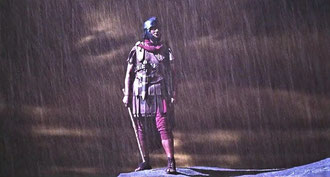
John Wayne was back on the MGM lot one more time, for another cameo, the Roman centurion in The Greatest Story Ever Told, in production from October, 1962, to July 1963. George Stevens directed the cruxificion sequence on the soundstage. Wayne’s single line, “Truly this man was the son of God,” was taped later in the recording studio. In 2010, MGM filed for bankruptcy. The studio complex is now Sony Pictures Studios.
universal
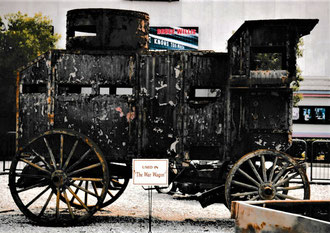
In 1915, Universal opened what was then the world’s largest motion picture facility, on a 230-acre converted farm just over the Cahuenga Pass from Hollywood – now called Universal City Plaza. John Wayne made six B-movies for Universal Studios, in the 1936-37 period. He returned to Universal as an A-Lister for The Spoilers, in 1942. Another 25 years later, Wayne made The War Wagon for Universal. Visitors of the Universal Studio Tour got treated to a rare sight by the side of a tram-tour road: one of the largest props ever built for a John Wayne movie, the War Wagon itself. The interior scenes for Hellfighters were shot on Stage 32; this was the Special Effects Stage, demolished in 2010.
rko radio pictures

John Wayne signed a multipicture contract with RKO Radio Pictures in 1945, one of the “Big Five” studios of the Golden Age of Hollywood. It was then located along Gower Street, adjacent to Paramount Studios. Without Reservations, his first RKO picture (seen here with Claude Colbert in a typical studio rear projection shot), was Wayne's only movie that dealt with the makings of motion pictures. The opening shot shows a fictional motion picture studio – that’s the actual RKO building at 780 Gower Street.
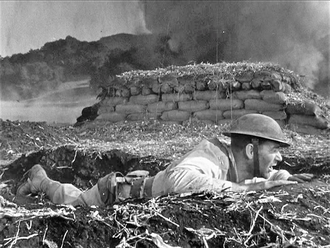
From November 6, 1944, to March 2, 1945, John Wayne was working on Back to Bataan. RKO transformed its backlot, the Encino Ranch, into the islands of the Philippines (this screenshot captures the moment just before John Wayne is jerked out of his fox hole by wires, attached to a crane, to simulate the effect of an explosion). The backlot covered eighty-nine acres, bordering by Louise on the West, Balboa Park on the East, Burbank Boulevard on the South and Oxnard on the North. Just months before, John Wayne had fought a range war at the RKO Ranch, in Tall in the Saddle .
paramount pictures

This is the original painting, used in the Paramount logo, now on display at the Academy Museum of Motion Pictures, on 6067 Wilshire Blvd in Los Angeles, as seen in several of John Wayne's paramount movies. John Wayne started his association with Paramount with Born to the West (aka Helltown), which was slightly better than the usual B-movie westerns of this era. He came to work for the founding father of the Paramount studio, Cecil B. DeMille, when he was a full-fledged star.

Paramount, once RKO’s next-door neighbor, is by now the sole member of the classic “Big Five” still located in the L.A. neighborhood of Hollywood. Its Bronson gate, one of movieland’s iconic symbols, is located near the intersection of Melrose and Bronson Avenues. John Wayne walked through that gate between May 26 and August 19, 1941. Reap the Wild Wind was produced completely on the Paramount lot. Even though the film plays in the Florida Keys, Cecil B. DeMille never left his home studio. In this studio still photograph, John Wayne is pictured in costume als Captain Jack Stuart.

For the famous scene of the attack of the giant squid in Reap the Wild Wind, in which John Wayne meets his end, Paramount built a 175 by 195 feet tank,for a cost of $50,000. It held a capacity of 91,423 gallons. It is now referred to as “B” tank on the Paramount lot.

John Wayne knew his way around the Paramount lot to Stage 12. On that Stage, Howard Hawks built the set of the saloon in El Dorado as well as the Momella Game Farm interiors for Hatari!. John Ford used the same stage, number 12, for the bedroom sets for Donovan’s Reef . All three films shared Stage 9 with The Man Who Shot Liberty Valance . This soundstage, to Trekkies, is known as "the Star Trek Stage".
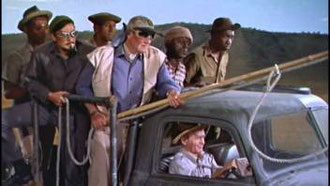
Stage 2 was Paramount’s process stage. When an actor is seen in the backseat of a car, he would be positioned in front of a transparency screen. John Wayne was acting in the Hatari! process shots here, standing on the mock-up of the herding car, as well as the speedboat process shots from Donovan’s Reef , using the same technique for McLintock the same year when process shots were required for buggy scenes.
paramount ranch

The Paramount Ranch, the famous western town on Cornell Rd in Malibu, burned down in one of the 2018 wildfires. John Wayne worked on the premises just once, in his first Paramount western Born to the West (re-released as Hell Town), in production from August 20 to September 4, 1937. The „Rancho Paramount“, as it was known then, had become a property of Paramount Pictures in 1927. Nevada, starring a young Gary Cooper, was one of the very first productions. The property went through the hands of several individuals. When RKO sold its Encino Ranch in 1954, the owner of the Paramount lot purchased some of the RKO buildings and actually moved them to the Agoura hills. In 1980, the National Park Service purchased the land and surrounding acreage (436 acres); the scenic western town was then rebuilt and opened to the public.

At the time the blaze leveled the Paramount Ranch, the buildings were in use for the HBO hit series Westworld. After so many years, the setting of Born to the West has now vanished. However, the little church shown in this shot and just dressed for a scene in Westworld survived the fire.
©All text content on this website is protected by copyright and other intellectual property laws. No part may be reproduced without the prior written permission. All photos courtesy of Roland Schaefli, unless otherwise stated.
This website is in no way associated with the John Wayne Estate or business enterprises. Go to johnwayne.com to find the official website and to https://johnwayne.org/ to read about the wonderful John Wayne Cancer Foundation.
more john wayne locations to scout
If you like this site, you'll like the book: the first comprehensive guide to the John Wayne Locations, with hundreds of then-and-now photos, unpublished behind-the-scenes-pictures and detailed tour descriptions
Tracking John Wayne: The complete Tourguide
Find directions to locations and anecdotes from the Duke's movie sets in this new publication from McFarland, available at bookstores and online shops
For all locations mentioned on this website, the book offers behind-the-scenes stories, making-of anecdotes and never before published photos

